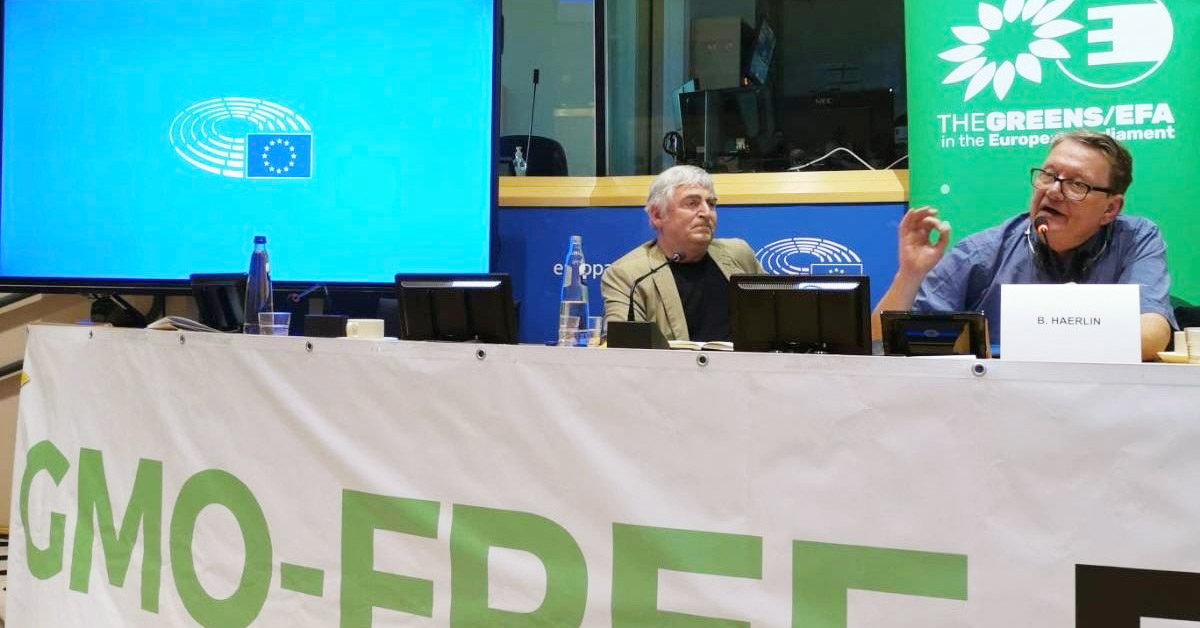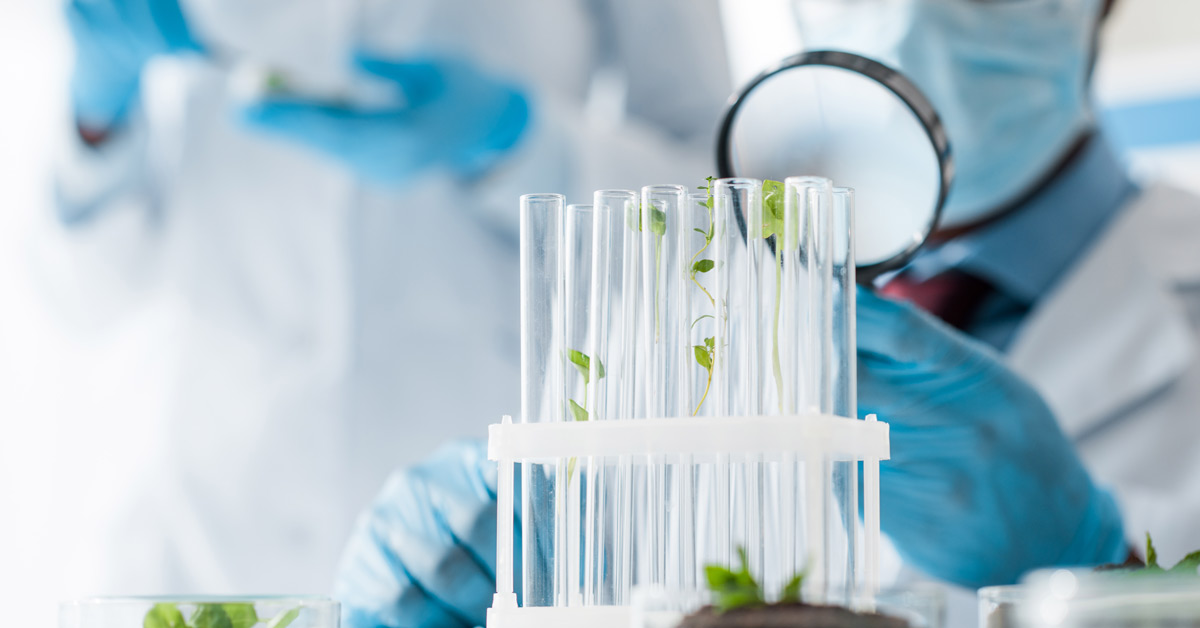EU Commission’s GMO deregulation plans face strong opposition at GMO-Free Europe conference
On 7 September the GMO-Free Europe conference took place in Brussels. The conference, hosted by the Green Group in the European Parliament, brought together people from the campaigning, scientific, food retail, legal, and policymaking sectors to discuss their opposition to the European Commission’s proposal to remove regulatory safeguards, traceability and labelling from new GMOs made with so-called “new genomic techniques” (NGTs) such as gene editing. There was a series of very interesting presentations about the damaging impact of the proposal, some of which we summarise here. Scientists Dr Ricarda Steinbrecher of Econexus in the UK and Dr Margret Engelhard of Germany’s Federal Agency for Nature Conservation warned that new GMOs pose risks to health and the environment that must continue to be assessed. Dr Engelhard cited research revealing that the vast majority – 94% – of new GMO plant applications fall into the Commission's “NGT category 1”, meaning that they would escape risk assessment for health and the environment, as well as traceability and labelling.
GMO-Free Regions conference recordings available
Recordings of all the presentations at the GMO-Free Europe conference on 7 September in Brussels (including translations) are available here and here.
Expert opinion: EU Commission’s genetic engineering deregulation plans are illegal
The EU Commission’s plans to deregulate genetic engineering violate the EU Constitution, according to a legal opinion. For food manufacturers, the result would also be significant legal uncertainties. According to the report, the Commission’s plans to abolish risk assessment and compulsory labelling for a large proportion of new genetic engineering methods violate the precautionary principle enshrined in the EU’s fundamental law, the Treaty of Lisbon. It would also violate the Cartagena Protocol, which is binding under international law. It requires that case-by-case risk assessments be carried out before GMOs are placed on the market.
Testbiotech warns about the far-reaching deregulation of new GM plants
Testbiotech has published a comprehensive analysis of the EU Commission proposal for the future deregulation of new GM plants. Currently, all organisms derived from genetic engineering processes must undergo risk assessment before they can be released, cultivated or consumed as food. The Commission now wants to abandon this basic principle of EU legislation. Testbiotech is warning against such far-reaching deregulation. Most new GM plants will in future simply need to be registered and will not be subject to the mandatory risk assessment currently required. New GM plants will be legally equated with conventionally bred plants (deregulated) even if they are biologically different. The new legislation would not only apply to annual crops. Wild, non-domesticated species, such as trees, wild herbs, grasses, mosses or algae, which can also spread in particularly sensitive ecosystems, could also be approved for release into the environment without further controls. The consequences for nature and the environment would not be monitored, and there would be no concepts or measures for removing new GM plants from the environment if this became necessary.
Organic processing and trade body calls on EU legislators to stand up for agroecology, which excludes gene editing
In a position paper, the organic processing and trade organisation OPTA Europe calls on EU legislators to stand firmly on the side of agroecology: “As the EU stands at a crossroads concerning the future of our food system, we invite lawmakers to stand firmly on the side of agroecology, which excludes gene editing”. OPTA Europe asks the Parliament and Council to amend the Commission’s GMO deregulation proposal with binding provisions requiring:
* Mandatory traceability and labelling of all new GMOs to protect the integrity of the organic supply chain
* In line with the polluter-pays-principle, new GMO manufacturers must bear the additional costs related to prevention and monitoring in the organic supply chain, as well as a compensation to the organic operator when damage or presence of new GMOs is confirmed.
Survey: Almost everyone wants labelling and risk assessment for new genetic engineering
The vast majority – 92 percent – of Germans want new GM foods produced using techniques such as gene editing to be labelled at all times. As many as 96 percent endorse mandatory risk assessment for new GM plants. The non-GMO industry association VLOG says the German food and agriculture minister Cem Özdemir must stop the plan of the EU Commission, which wants to abolish both.
Hungary: GMO-free farming remains top priority
The Hungarian government has rejected the proposal of the European Commission to abolish the right of self-determination of Member States and the labelling obligation of plants produced with new genetic engineering techniques. The Ministry of Agriculture said, "The country is strongly committed to GMO-free agriculture. It is reflected by the new Fundamental Law, entering into effect in 2012, setting the goal of ensuring GMO-free food and agriculture in Hungary."
CRISPR causes serious DNA damage with high frequency – but it’s often overlooked
The latest in a long series of papers has been published detailing unintended effects of CRISPR gene editing. The new review summarises the many types of serious unintended on-target (at the intended edit site) DNA damage resulting from CRISPR/Cas gene editing. The review appears as the European Commission and the UK government maintain their pretence that gene editing is a precise, predictable, and controllable technique and that food plants made with this technology are therefore as safe as those produced by conventional breeding. The authors of the new paper reviewed the literature on CRISPR gene editing in human, primate, and mouse cells. They found that CRISPR-induced double-strand breaks in the DNA caused numerous large unintended on-target genetic damages, including large and small deletions and insertions, and chromosomal rearrangements of genetic material. And they note that even large on-target gene modifications are not detectable by standard methods.
Gene editing found to cause chaos in the genome of tomatoes
Recent scientific findings have revealed chromothripsis-like effects after the application of CRISPR/Cas gene editing in the genome of tomatoes, reports Testbiotech in an article commenting on a just-published preprint study. Chromothripsis is a phenomenon in which often several hundred genetic changes occur simultaneously in a catastrophic event. Many sections of the genetic material can be swapped, recombined, or even lost if this occurs. It has been known for some time that chromothripsis occurs in mammalian (including human) cells. But now this effect has also been demonstrated in plants after gene editing applications. The findings show that gene editing applications cause unintended genetic alterations much more frequently than previously thought, affecting large parts of the genome. Molecular geneticist Prof Michael Antoniou commented, “Yet again we see a phenomenon that has already been observed in a human cell context – major DNA damage from gene editing – now appearing in plants. Due to the inadequate analysis that is generally done in gene-edited plants, GMO developers will often miss this. So we will end up with marketed products with major genetic rearrangements affecting the function of many genes, even disturbing the balanced expression of multiple gene families, with unknown downstream consequences to the biochemical composition of the plant. Those consequences could include the production of new toxins and allergens. Yet gene editing is claimed to be more precise than natural breeding. Clearly this is not the case.”
New study warning of dangers of gene editing in human embryos has relevance for agricultural GMOs
Scientists have discovered that the cells of early human embryos are often unable to repair damage to their DNA caused by the CRISPR/Cas gene editing process. The researchers say that this has important implications for the proposed use of gene editing to repair mutated genes that underlie serious inherited diseases, as well as for in vitro fertilisation (IVF) in general. GMWatch sought the opinion of Prof Michael Antoniou, who uses genetic manipulation techniques, including gene editing, in clinical research. What he told us suggests that the new findings likely will kill attempts to carry out human germline editing in humans using CRISPR/Cas – and that attempts to get around the problem by using alternative genetic manipulation methods may also prove problematic. Prof Antoniou said the findings also have relevance to some agricultural gene-edited GMOs – certainly to animals and possibly to plants, casting yet more doubt on the viability and safety of these types of GMO.
Assessing potential environmental effects of gene-editing applications for plants
The current EU biosafety regulation framework requires a mandatory environmental risk assessment of GM products prior to the authorisation of individual GMOs for environmental release or marketing in the EU. Considering the different characteristics of specific examples of gene-edited plants and relevant risk issues, a recently published paper states that it is neither appropriate nor scientifically justified to draw general conclusions for whole groups of gene-editing applications. The paper contends that gene editing and conventional breeding are two fundamentally different approaches. With a view to the significant differences concerning the relative frequencies of mutational events at specific genomic locations, the authors argue that a general “likeness” between genome-editing approaches and conventional breeding techniques cannot be assumed until such claims are supported by environmental risk assessment results.
Organics advocacy body IFOAM publishes protocol for global safety and risk assessment of new GMOs
The IFOAM Seeds Platform has published the Global Safety and Risk Assessment Protocol for New Genomic Technologies, a new guidance for governments and the private sector for the assessment and regulation of new GMOs (also called NGTs or new genomic techniques). IFOAM said, “This new and highly disruptive technology is an existential threat to organic and agroecological systems worldwide and poses widespread risks to human health, biodiversity, and environmental stability. This new Risk Protocol proposes a sound and scientific approach that fills a huge gap in the regulatory landscape and the public understanding of the potential danger of unintended negative effects of NGTs.” Among the recommendations of the protocol is: “All products of genetic engineering shall be disclosed so that regulatory oversight is enabled and consumers can make informed choices. Labelling shall transparently and clearly divulge in commonly understandable terminology the changes made through the genetic engineering.”
Canada: Science takes a back seat with federal gene editing decision
Even though they have no history of safe use in Canada or elsewhere, Agriculture Minister Bibeau announced in May 2023 that Canada will exempt gene-edited plants from regulation and mandatory public notification unless they contain foreign DNA or if they are herbicide tolerant. For all other changes in a gene-edited plant, it is up to the company to decide whether their product might cause an environmental harm and thus should be assessed by the Canadian Food Inspection Agency (CFIA). There is no way for the public to know whether a biotech company’s assessment was thorough, and no mechanism to ensure it reports any troublesome impacts it might discover, writes Cathy Holtslander, NFU Canada’s Director of Research and Policy.
First CRISPR-edited salad hits the US market
Food startup Pairwise, which is in a strategic alliance with Bayer and whose CEO was previously a Vice President at Monsanto, has launched its Purple Power Baby Greens Blend, the first gene-edited product using CRISPR technology sold in the US. A mix of purple and green mustard greens, the new salad blend was gene-edited to taste less bitter and more like lettuce. Jennifer Kuzma, co-director of the Genetic Engineering and Society Center at North Carolina State University, called for more transparency. She’d like to see regulatory and safety documents made publicly available for CRISPR-edited foods. In GMWatch’s view, the whole point of mustard greens is that they taste... well, like mustard. If you want something that tastes like lettuce (of very little), you buy lettuce. Mustard has anti-cancer, antimutagenic, antioxidant, and antifungal properties, among other therapeutic effects. We haven’t seen any analysis of whether the CRISPR-edited mustard greens have retained those beneficial properties, or lost them with the edited-out bitterness.
..................................................................
We hope you’ve enjoyed this newsletter, which is made possible by readers’ donations. Please support our work with a one-off or regular donation. Thank you!




